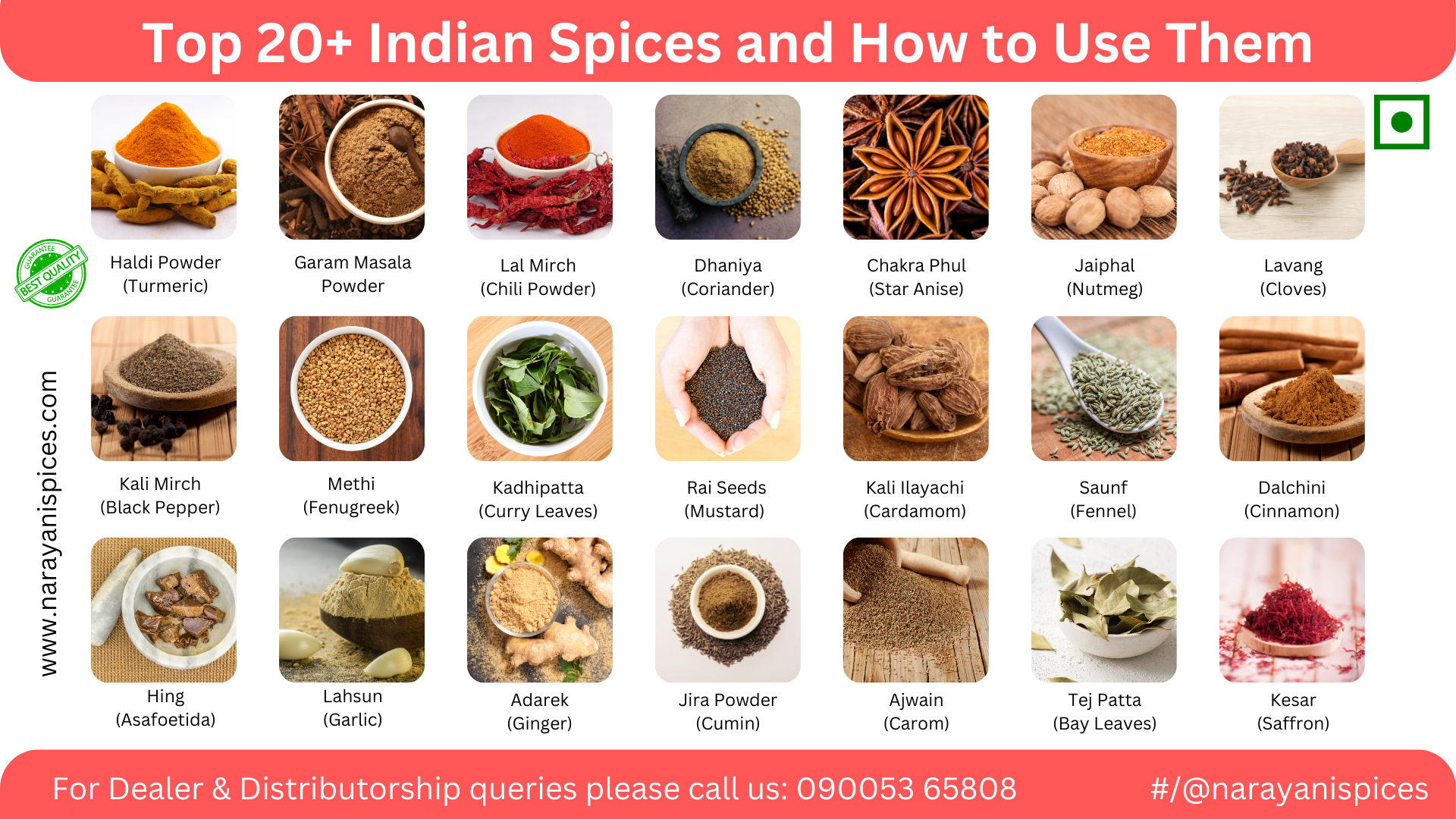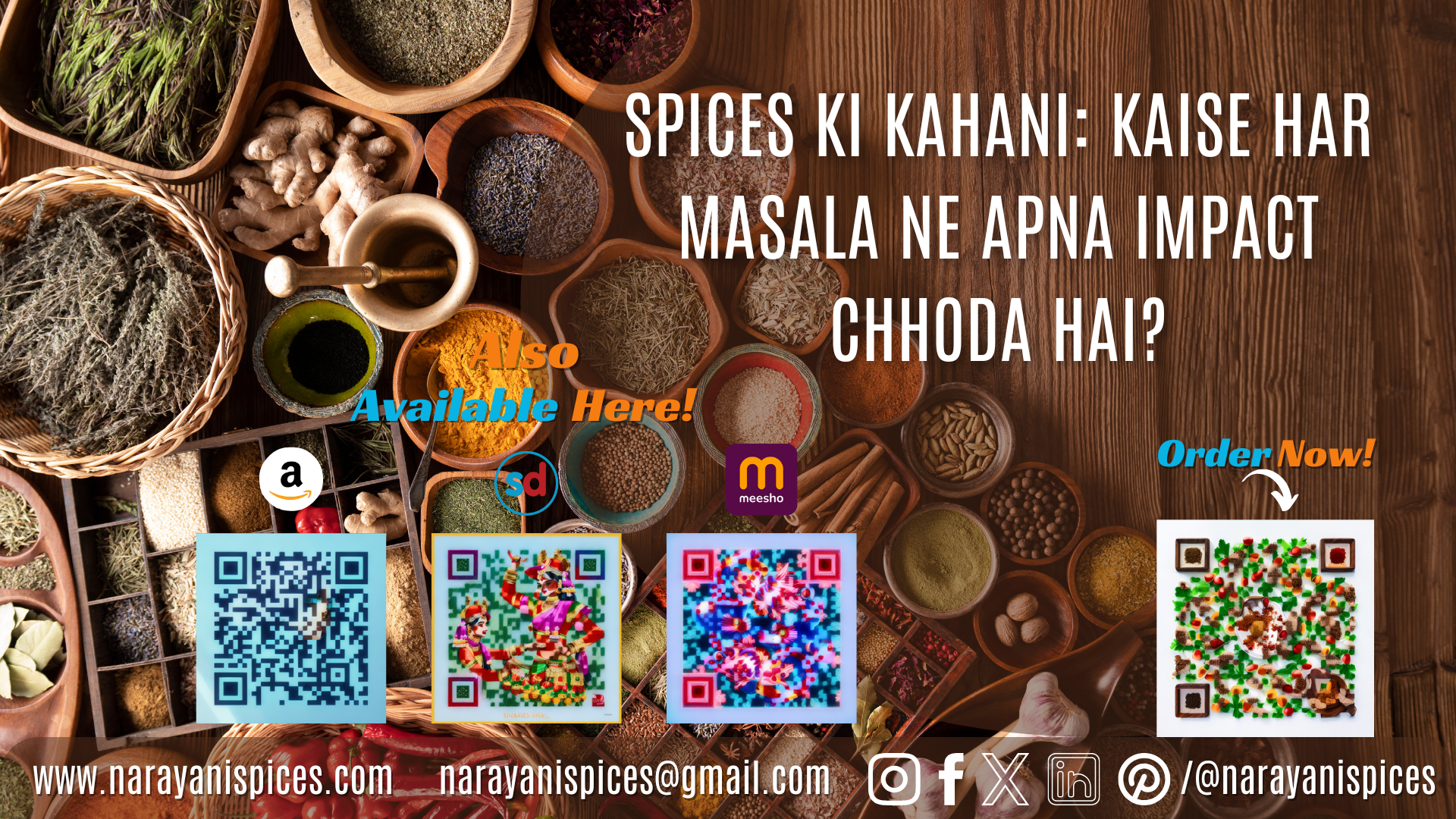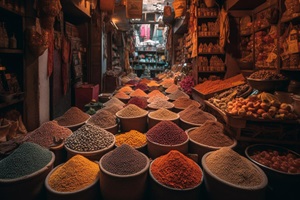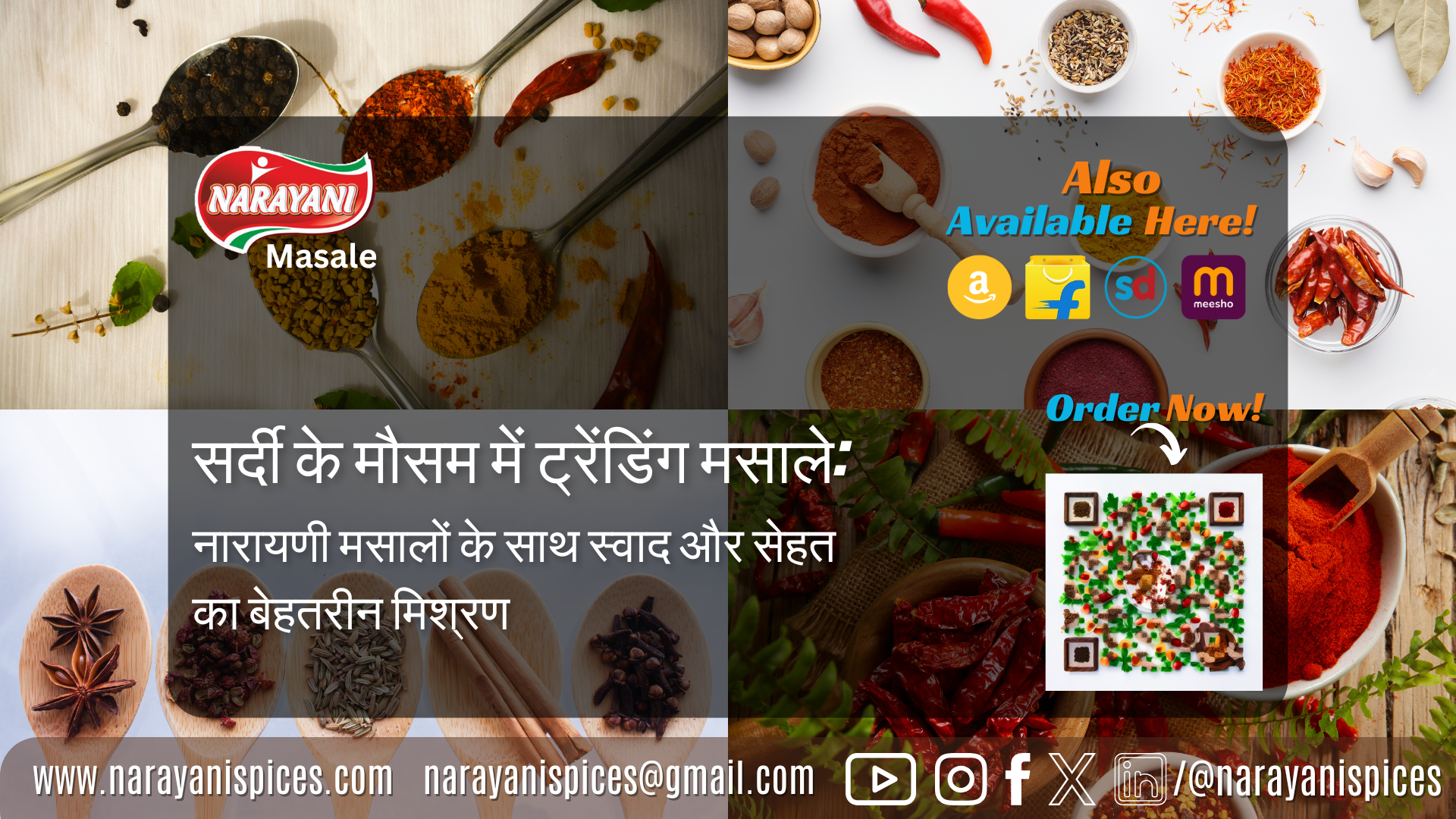If there is one thing that defines Indian quilted food, it is the variety of vibrant spices that have been enjoyed for centuries. From the vibrant earthiness of cumin to the fiery pulse of chili, Indian spices are the heart and soul of countless dishes, tempting flavors that tempt and ignite culinary appetites At the Narayani Spices we feel a deep sense of importance under these aromatic gems, and that’s why we curated a list of the top 20+ Indian spices.
- Turmeric (Haldi)
Turmeric is necessary for Indian cuisine. The pulverized spice turmeric has a supplementary earthy flavor. This spice is the most healthful of all the spices used in Indian cooking, and it’s an amazing shade of yellow. For a family of four, a teaspoon is usually all that is needed to flavor and color a dish. If using for health reasons, make sure your recipes call for at least a dash of black pepper. While piperine from black pepper enhances the anti-inflammatory properties of Turmeric, its benefits are not as strong without it.
- Garam Masala
Garam Masala is the most well-known seasoning in India. In actuality, it’s a blend of several dry spices, such as tej patta, cumin, coriander, cinnamon, nutmeg, cardamom, and pepper. It is a common ingredient in many recipes, such as Chana Masala. While your sauce is simmering or your onions are frying, add one to two teaspoons. It is occasionally used as a garnish.
See our post on preparing Garam Masala for use in Indian cooking. It should be noted that Garam Masala has the widest variety of all the spices. It’s unlike any other spice in that the list of components varies greatly from place to place, and as a result, so does the taste. Whether it’s mustard, fennel (some a lot, some not at all), or a combination of spices, this spice is almost certainly going to be a component in whatever Indian meal you consume.
- Red Chili Powder (Lal Mirch)
Similar to cayenne pepper, Indian Red Chili is a ground spice whose heat level varies based on the growing region and method of the chilies. Its flavor is typically brighter red and more flowery than cayenne. When modulating the dish’s heat towards the finish, this is another nice ingredient to add gradually.
- Carom (Ajwain)
Strong ingredients like Cardamom are found in many Indian recipes. Because each tiny carom fruit contains a large amount of thymol, it has a flavor that is somewhat similar to thyme but much stronger. In India, using carrom in bread is a widespread practice.
Use it sparingly in Indian cooking; when fried first, it releases a smokey flavor that harmonizes nicely with mustard, cardamom, and cumin seeds, among other strong flavors.
- Star Anise (Chakra Phul)
Anise has a stronger, more pronounced flavor than fennel, often described as harsher and less sweet or flowery. While fennel brings a mild, sweet licorice taste, anise offers a more intense, peppery kick. In some Garam Masala blends, you’ll find star anise, which adds its unique, bold flavor to the mix. Star anise is also an excellent spice for frying, as it releases its rich, aromatic oils when heated, making it a key ingredient in many Indian dishes. One of its most delicious applications is in tamarind chutney, a popular dipping sauce often served in restaurants or with street food like chapatis, samosas, and other Indian snacks. The subtle heat and depth that star anise imparts to tamarind chutney elevate the flavor, making it a tangy and savory accompaniment that perfectly complements the crispy, spiced treats.
- Nutmeg (Jaiphal)
In India, whole, grated nutmeg is a staple, especially in south Indian cooking. You can either use a sharp knife to shave the whole spice. Shave the nutmeg with a sharp knife to use this spice. The Nutmeg can also be used in a taarka step hole or broken up into bigger pieces.
To prepare masalas (spice mixtures) for Keralan chicken curries and thattukada (street vendor) foods, nutmeg is toasted and ground with coconut, sesame, poppy, and mustard seeds, among other spices, in south Indian cuisine and many other Indian dishes.
- Cloves (Lavang)
Anyone who has ever prepared an Easter ham is well-acquainted with the bold flavor of Cloves. Known for their strong, aromatic taste, cloves can easily dominate a dish if used in excess, overpowering the more subtle ingredients. Typically, when cooking for a family-sized meal, only four to ten whole cloves are needed, as this amount provides enough flavor without overwhelming the dish. Cloves are incredibly versatile and appear in a wide range of cuisines, especially in Indian cooking. They are a crucial ingredient in biryani, where they contribute to the warm, fragrant aroma that defines this beloved dish. In Indian curries, cloves are often used alongside other spices to create complex, layered flavors, infusing the curry with their rich, slightly sweet and spicy taste. For dishes like Patiala chicken, cloves are an essential element, adding depth and an aromatic warmth that enhances the entire dish. Whether in slow-cooked stews, rice dishes, or meat curries, cloves bring a distinct and unforgettable flavor, making them an indispensable component of traditional Indian cuisine.
- Black Pepper (Kali Mirch)
Black pepper is a spice that almost everyone recognizes, thanks to its bold, sharp taste. Among the various types of pepper, black pepper stands out for its distinct level of heat and pungency, giving it a unique place in the world of spices. It provides a powerful, high-flavor punch that no other spice can quite match. When you add black pepper to a dish, its spicy kick is often the first sensation you experience, overpowering other flavors with its heat and intensity. This makes it an essential ingredient in countless cuisines, known for its ability to instantly awaken and enhance the flavors of any dish. Its versatility allows it to be used in everything from savory stews to marinades, giving it an enduring presence in kitchens worldwide.
- Fenugreek (Methi)
Fenugreek is one of the milder Indian spices. Despite their bitter taste, fenugreek seeds are incredibly beneficial to health. The leaves have a delightful perfume reminiscent of maple and are a fragrant green spice that is less likely to be harsh. Some believe this Indian spice “smells like curry.”
This may be the most important spice of all the Indian spices. Start with a teaspoon and work your way up to a few teaspoons in a family-sized meal at the end of cooking. Fenugreek seeds are also very beneficial to health.
- Curry Leaves (Kadhipatta)
Curry Leaves are among the most intriguing Indian spices, and they’re by no means the least significant. These leaves come from the Murraya koenigii plant, and although they may be purchased dried, they are best used fresh in the first or second stage of cooking, fried together with onions and your tadka spices to add a strong, citrusy flavor.
- Mustard Seeds (Rai)
Mustard seeds, in their brown, yellow, or black varieties, are a cornerstone of Indian cuisine. These small yet powerful seeds bring a distinctive nutty and pungent flavor to a wide array of dishes, especially curries. Like many other whole spices, mustard seeds are typically fried in oil at the start of cooking. This step helps release their essential oils, which infuse the oil and, in turn, the dish with a sharp, spicy aroma that enhances the overall flavor. Whether used in tempering dals, curries, or even pickles, mustard seeds are indispensable in creating the bold and complex tastes that are a hallmark of Indian food. Their versatility and ability to elevate dishes make them a must-have in every Indian kitchen.
- Cardamom (Kali Ilayachi)
One of the most important Spices on our list is black Cardamom seeds, which smell much like green ones do. The main distinction is that they are dried over a fire before being used in cooking, giving them a blackened and smoky flavor.
The distinct aroma of Black Cardamom cannot be replicated. They’re used in many recipes. Typically, just one or two full black cardamom pods are used in recipes that serve four people. These are frequently used in biryani, an Indian dish.
- Fennel (Saunf)
Anise and fennel share a similar flavor profile to black licorice, offering a sweet and aromatic taste. Fennel, in particular, plays a crucial role in Indian cuisine, especially in the preparation of dishes like Madras curry and other flavorful curries. It is often used to enhance the overall taste, bringing a unique, slightly sweet and savory essence to the dish. Fennel seeds are also a key component in taarka, where they contribute their aromatic richness when fried in hot oil. Moreover, candied fennel seeds are a popular after-dinner treat in many Indian restaurants, serving as a refreshing, minty option to aid digestion and freshen the breath. These versatile seeds are deeply embedded in culinary traditions, offering both savory and sweet delights across various meals and courses.
- Cinnamon (Dalchini)
Cassia bark is a staple ingredient in many Indian kitchens and can be easily found in most Indian grocery stores. It’s often used in cooking as a substitute for cinnamon, as both belong to the same family and share a similar flavor profile. In Indian cuisine, both cassia and cinnamon play a vital role in adding depth and warmth to various dishes. The process usually involves using whole pieces of cassia or cinnamon bark, which are first fried in hot oil or ghee at the beginning of cooking. This step helps release their rich, aromatic oils, infusing the dish with a distinctive spicy, sweet fragrance. Once the oils have been released, the bark is typically removed, although sometimes it is left to simmer further, allowing the flavor to continue melding into the dish. This technique is especially common in curries, stews, and rice dishes, where the warm, complex flavor of cassia or cinnamon enhances the overall taste.
- Asafoetida (Hing)
One of our favorite Indian seasonings is Asafoetida (hing). One of the world’s most potent and aromatic spices is hing, which is used in cooking.
Hing must always be added to a hot pan of oil or butter when using it. Before adding onions, Garlic, or Ginger, let it sear for a few seconds, 5 to 20. You should use around a quarter to a half teaspoon of hing for a dinner for four. Ensure that it is kept in a sealed container. Visit our Narayani Spices blog entry to learn more about this spice.
- Garlic (Lahsun)
How on earth is Garlic included in an Indian Spice list? It’s neither specifically Indian, nor is it a spice, but it’s a necessary part of Indian cooking.
Four to ten cloves of Garlic, according to the size of commercial garlic, can provide an excellent, substantial taste in a recipe for four people. Add it right at the beginning when you start frying your onions for a gentler taste, or add it later, after the onions are tender, to give the Garlic less time to cook, for a stronger flavor.
- Ginger (Adarek)
Of all the Spices used in Indian Cooking, Ginger is the most important component for the majority of curries and forms half of the formula for the paste that is used in most Indian dishes. You can use dried spices just fine. It’s even called for in certain recipes. Ginger and/or garlic paste are used in most Indian recipes. If you don’t have any, chop or grate a 1-2 inch piece of raw ginger and saute it with your garlic until your onions have become clear. Ensure that the Ginger has been peeled beforehand.
- Cumin (Jira)
A mainstay of Indian cuisine and curries, cumin seed has a flavor profile somewhat similar to that of caraway or dill. In general, it is better to utilize cumin seeds whole and to fry them in oil before adding them to a dish (a procedure known as taarka).
Cumin seeds will brown in around 15 seconds when heated at a higher temperature. When they begin to pop, you will know they are done; just be careful not to burn them. Another important spice used in India is ground cumin powder, which is one of the main components of garam masala spice blend.
- Coriander
One of the most important spices on our list is Coriander, which is the seed of cilantro.
This seed is used in numerous recipes, such as Vindaloo and Madras, and has a citrusy scent with undertones of wood and leaves. The greatest usage for coriander seeds is to ground them into a powder right before adding them to a sauce.
- Bay Leaves (Tej Patta)
Tej Patta is used much the same way as European bay in Indian cookery. Included whole, it is often cooked for the entire meal before being taken out right before serving. It has an aromatic flavor that tastes like cloves and cinnamon.
Usually used at the start of a meal, Tej Patta leaves are browned slightly and combined with cardamom pods, mustard seeds, cumin seeds, and other frying spices.
- Saffron
The precious and opulent Spice Saffron, sometimes referred to as the “king of spices,” is made from the delicate stigma of the Crocus sativus flower. Saffron, which has a strong flowery scent and a vivid scarlet color, gives food depth and richness even when used little. Saffron has been valued for its culinary, medicinal, and ceremonial applications due to its long history and cultural importance. Saffron is renowned across the world for its distinct and refined flavor profile, which is used to enhance the richness of Persian rice dishes and flavor paella in Spain. It is one of the most costly spices in the world because of its labor-intensive harvesting method, which entails meticulously hand-picking the fragile stigma from each bloom.





